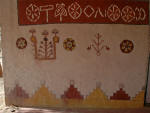The remains of Dholavira, a major city of the Harappan civilization, were discovered in 1967-68 by J. Joshi. Though hundreds of Harappan sites have been identified in Gujarat, Dholavira is among the five biggest known to us in the Indian subcontinent. "The excavation at Dholavira brought to light a remarkable city of exquisite planning, monumental structures, aesthetic architecture and amazing water management system." Indeed, to the casual visitor, the most notable feature of this metropolis of the 3rd millennium BCE is its water management acumen. Sixteen reservoirs of various sizes have been identified, of which five have been excavated fairly well. There is extensive water harvesting throughout the site. The ingenuity in handling water is evident in the waterways and channels that crisscross the site. (read more) [—Apr 06]
Update: Read my article on Dholavira in The Himal Southasian.
The citadel (more)  | South-east corner  | Eastern walls of the citadel  | East entrance  |
 | Steps down the tank  | ||
 |  | ||
A granary  | South entrance to citadel  | The Bailey (servant homes)  | Top of the citadel  |
The well  | Bathing area (more)  | ||
Water tank  | Remains of citadel rooms  | ||
Shard-studded wall  | Corridor inside citadel  | Circular rooms (more)  | Former royal chamber?  |
Eastern entryway  | Passageway inside citadel  | Passageway  | Brickwork from two eras  |
Water harvesting conduit  | Water harvesting conduit  | A fine pillar base  | Tourist bungalow from the citadel  |
North-eastern corner  | Northern wall  |  | Northern wall  |
North entrance  | Writing over the north entrance, "the oldest signboard in the world"  | Stadium from north entrance  | Stadium from middle town  |
Middle town ruins  | Market street (more)  | Market street  | Four-way intersection  |
Side street  | Waste receptacle  | Fragments of the past  | Fragments of the past  |
Cemetery area (local flora)  | The largest water tank (more)  | The largest water tank (more)  | Women near the ruins  |
Dholavira signpost  | Across the Great Rann of Kutch  | Saline mudflats (more)  | Great Rann of Kutch (more)  |
Rabari tribeswoman (more)  | Rabari tribeswomen  | Local woman  | Local woman  |
Local women  | Local women (more)  | Local women  | Tribal family (more)  |
Path to the excavated site  | Traveling hundreds of miles in summer to this isolated site near the western edge of India, I encounter this sign put up by the Archaeological Survey of India (ASI). Shaking my head in disbelief, I ask: Why? What can possibly be the rationale for prohibiting photography here? ASI ought to be marketing this site, a global cultural heritage, and providing better facilities (e.g., a site museum, a brochure, guides). I recall that the ASI also bars photography at nearly all of its site museums, of works with long expired copyright claims. Why? Nobody ever has a good answer ('orders from above' is the most common). 'Apply for permission in Delhi,' they say. If this isn't the product of a bureaucratic mind I don't know what is. Annoyance again wells up within me. Stupid rules need not be followed, I tell myself, and resolve to flout the injunction, if need be by cajoling or bribing the lone caretaker on site, or sneaking in behind his back. [BHAVESH] | ||
No comments:
Post a Comment